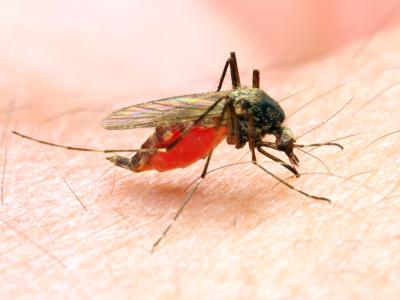European analysis links antimicrobial resistance to climate change
New research presented at the European Congress of Clinical Microbiology and Infectious Diseases (ECCMID) annual meeting suggests an association between antimicrobial resistance (AMR) and climate change.
Using statistical analysis and computer modeling, a team of German researchers looked at more than 900,000 bacterial isolates collected from 30 European countries over a 6-year period and found significant associations between the warm-season mean temperature and methicillin-resistant Staphylococcus aureus (MRSA), multidrug-resistant Escherichia coli, and carbapenem-resistant Klebsiella pneumoniae.
The researchers also observed that the warm-season mean temperature was a stronger predictor of MRSA variation than outpatient antibiotic use, and that carbapenem-resistant Pseudomonas aeruginosa (CRPA) was significantly associated with a warm-season change in temperature of 0.5°C (0.9°F).
The authors of the study conclude, "These results reveal two aspects: climatic factors significantly contribute to the prediction of AMR in different types of healthcare systems and societies, while climate change might increase AMR transmission, in particular CRPA."
The study builds on research published in 2018 by a team of US scientists that found that an increase in the average minimum temperature across US regions was associated with higher levels of AMR in E coli, K pneumoniae, and S aureus.
Apr 14 ECCMID abstract
Apr 14 ECCMID poster
May 23, 2018, CIDRAP News story "Study finds antibiotic resistance tied to hotter temps"
Study identifies petting zoos as potential source of MDR pathogens
A study presented at ECCMID by Israeli scientists suggests that petting zoos could be a reservoir for multidrug-resistant (MDR) pathogens, potentially posing a threat to people who visit the facilities.
The prospective cross-sectional study was performed in eight petting zoos throughout Israel from December 2016 to May 2018, with researchers collecting fecal and body-surface samples from 228 animals belonging to 42 different species. They identified the bacteria, susceptibility profile, and sequence type (ST) in each sample and used polymerase chain reaction and whole-genome sequencing to identify extended-spectrum beta-lactamase (ESBL) and AmpC-carrying Enterobacteriaceae (AmpC-E). They also analyzed questionnaires filled out by zoo owners to determine risk factors for carriage of drug-resistant pathogens.
Analysis of 382 samples revealed that 12% of the animals (28 of 228) carried at least one ESBL/AmpC-producing bacterial strain, with 35 different types of bacteria identified. Seventy-seven percent of the recovered bacterial types were from fecal samples, and 23% were from skin/fur/feathers. Twenty-five percent of the animals carrying ESBL/AmpC-E were co-colonized with more than one strain.
The main bacteria recovered were Enterobacter spp (55%), E coli (31%), and Citrobacter spp (14%). Among the strains identified were the highly virulent enterotoxigenic E coli ST 656, a known cause of traveler's diarrhea, and E coli ST127, which causes urinary tract infections in people.
Analysis of risk factors found that animals treated with antibiotics were more than seven times more likely to carry an MDR pathogen (odds ratio, 7.34).
"Our findings demonstrate that animals in petting zoos can result in shedding and transmission of MDR pathogens that may cause illness for human visitors, even when the animals appear healthy," lead study author Shiri Navon-Venezia, PhD, a microbiologist at Ariel University, said in an ECCMID press release. She and her colleagues suggest petting zoos should implement strict hygiene and infection-control policies to reduce the risk of animal-visitor transmission.
Apr 14 ECCMID abstract
Apr 14 ECCMID poster
Apr 13 ECCMID press release
Study: Bloodstream infection mortality rate varies by organism
In another abstract presented at ECCMID, a retrospective analysis of hospitalized patients from 10 New York healthcare facilities found a wide range of mortality rates associated with bloodstream infections (BSIs) caused by different antibiotic-resistant pathogens.
The researchers sought to evaluate the association between different microorganisms and in-hospital mortality in patients with BSIs by analyzing patients discharged from the 10 facilities over 12 months (January to December 2018). For suspected BSI patients who'd had blood cultures taken, the investigators sent the cultures for molecular analysis to identify the species of microorganism present in the blood. They then grouped the discharged patients by organism type and discharge disposition to assess in-hospital mortality rates by organism.
Overall, 212,257 patients were discharged during the study period, and 4,133 (2%) involved the death of a patient. Of the 6,149 patients who were found to have a BSI caused by one or more microorganism, 744 (12%) died in the hospital. The mortality rate for BSI patients ranged from 8% to 46%, with the highest mortality rates associated with Acinetobacter baumannii (46%), vancomycin-resistant Enterococcus (36%), carbapenem-resistant K pneumoniae (35%), and Candida species (30%). The analysis also found that illicit drug use, pressure ulcers, and acute kidney injury were strongly associated with BSIs, and that coagulase-negative Staphylococcus, typically considered to have low virulence, was associated with a 13% mortality rate.
The authors of the study conclude that molecular identification of organisms with high mortality rates could be crucial in helping clinicians identify the right antibiotic to treat the infection.
Apr 13 ECCMID abstract
Apr 13 ECCMID poster
Study finds drug-resistant pathogens fairly common on patients' hands
A study of patients in two Michigan hospitals reveals that 14% were colonized with a multidrug-resistant organism (MDRO), 10% had an MDRO on their hands, 29% of rooms harbored an MDRO, and 6% of patients acquired a new MDRO on their hands while in the hospital, according to the findings, which appear in Clinical Infectious Diseases.
University of Michigan researchers analyzed data on 399 patients who were enrolled in the study within 24 hours of arrival to their hospital room and had swabs taken from their nostrils, dominant hand, and six high-touch surfaces in their room on admission and weekly until discharge. The authors note that the role of healthcare worker hand contamination in MDRO spread has been well studied, but not the role of patient hand contamination.
The team found that 56 of 399 patients (14.0%) were colonized with MDROs at baseline, 40 of them (10.0%) on their hands. They also discovered that 29% of rooms harbored MDROs, and 14 of 225 patients who had at least two visits (6.2%) had newly acquired MDROs on their hands during their stay. Genetic typing also determined a high correlation between acquiring MRSA on patients' hands and MRSA on room surfaces.
The authors conclude, "Patient hand hygiene protocols should be considered to reduce transmission of pathogens and healthcare-associated infections."
Apr 13 Clin Infect Dis abstract
European, Duke University researchers join efforts to combat resistance
European researchers and a group based at Duke University announced a new joint effort to tackle antibiotic resistance issues, according to a news release from the Duke Clinical Research Institute (DCRI).
The US-based Antibacterial Resistance Leadership Group (ARLG), part of the DCRI, and the University Medical Center (UMC) in Utrecht, the Netherlands, which manages the COMBACTE (Combatting Bacterial Resistance in Europe) consortium, "will work together to solidify a comprehensive global community to combat the threat of antibiotic resistance around the world," according to the release.
The collaboration will include jointly designing and conducting clinical research, holding working meetings at conferences like ECCMID, exchanging data and protocols, and other cooperative efforts. It will also help avoid duplication of efforts.
"We at the ARLG have long admired the work being done by COMBACTE to increase the efficacy of antimicrobial drug development," said Vance Fowler, MD, an investigator at the DCRI and co-principal investigator of the ARLG. "Combining our efforts will allow us to maximize the work we both do to stop the advancement of antibacterial resistance."
"We have already made efforts to expand our reach across Europe, where an increasing number of people suffer from infections caused by antibiotic-resistant bacteria," said Marc Bonten, MD, coordinator of COMBACTE and a professor at UMC Utrecht. "But by collaborating and sharing our progress with the ARLG, we can make a truly global impact beyond this population—an important consideration in a globally connected era in which epidemics travel across oceans quickly."
Apr 13 DCRI news release














